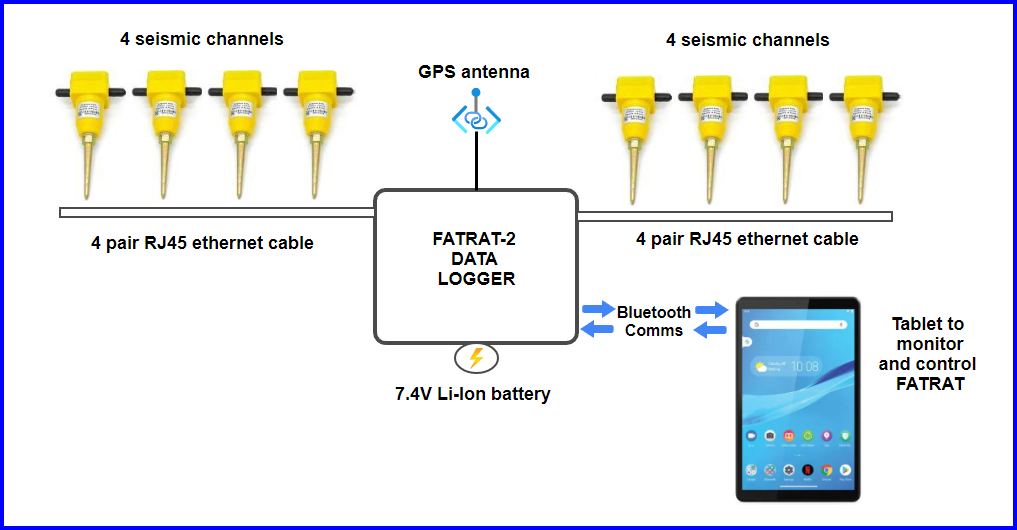CONVENTIONAL SEISMIC SYSTEM
The original seismic
system operated by Geocon in Thailand, called WOFSS, was based around a multipair cable system that
brought geophone signals to a central data acquisition system. Each geophone channel went through an
amplifier and the data acquisition was controlled by a standard desktop PC
containing a high quality Analog to Digital Converter (ADC) board. Data was processed on a shot by shot basis
and data saved on a hard disc in a standard SEGY format.
The concept of this system is shown below

There are conceptual
advantages to this system and some disadvantages.
Advantages
- Each
seismic record is made in real time and hence data quality of the record is
available to a field observer who can perhaps change recording parameters to
get better quality data
- Amplifiers
are inside the recording system and provide up to 90dB gain prior to signal
going to ADC
- The Geocon
WOFSS system also had data processing capability in the software so individual
records could be stacked into field stacks to guide further seismic line
placement
- Each day
ALL equipment was picked up and returned to camp.
Disadvantages
- The cables
are bulky and require specialist maintenance.
100 pairs of wires in a “smallish” cable require an experienced
repairman
- The cables
are NO LONGER manufactured and would be expensive if Custom made
- The number
of channels available is FIXED and determined by the cables. In the case of GEOCON this was a total of 200
channels and this meant to carry out conventional acquisition a maximum of say
140 channels per seismic record to allow a 60 channel roll-along before
instruments had to move and reconnect to the line
- Power was
supplied by 200V 50Hz genset and no matter how much filtering is done in power
supply some 50Hz will always get into a seismic record as seismic signals are
small
- Similarly,
if working anywhere near mains power poles (i.e. such as along a small road)
then the cables make great antennas to pick up the 50Hz from current flowing in
the mains power poles and causing crossfeed into all of the 100 pairs in the
cable
DISTRIBUTED SEISMIC SYSTEM
The world has now
moved onto a distributed seismic system approach where nodes with geophones
attached (or built in) are deployed as data loggers and these simply
continuously acquire data 24 hrs a day.
The energy source will also have its output recorded by a separate node
and then data is harvested from all of these nodes and post compiled/processed
into conventional seismic records. A
mechanism to time-stamp the data from both energy source and geophone channels
is absolutely essential to such a system.
The very convenient system to achieve this is from the 1 second time
pulse available from high quality GPS receivers. GPS relies on accurate timing signals and the
1 second time pulse (called 1PPS – 1 pulse per second) is accurate to a few
nanoseconds.
FATRAT (v2) is such a distributed system. FATRAT = Fire Any Time Record All the Time
Concept of FATRAT2 is shown below

The industry-accepted
market-dominated distributed system is called SmartSolo which is Chinese and
offers nodes as either 5Hz or 10Hz as standard.
Even in bulk quantities a single channel is about US$150 (based on
information from Velseis). Brochure is
in Appendix 1.
The SmartSolo uses a
24 bit ADC and has gain capability of up to 36dB in some models and 24dB as
standard. FATRAT2 does NOT
want to compete with SmartSolo but rather be a boutique seismic system that is
cheap to build and maintain plus is designed around readily available
commercial electronic modules.
FATRAT2 uses CAT5
or CAT6 commercial ethernet cable to link 4 channels either side of the field
data logger. Each channel will have its
signal pass through the same amplifiers as used in the WOFSS system.
FATRAT (v2) uses either a
12 bit or 16 bit ADC but due to the high gain amplifier (90db = 15 bits) is
effectively a 27 or 31 bit acquisition system.
Advantages
- FATRAT2 is
modular 8-channel system hence the total number of channels in the field is NOT
limited and simply depends on how many modules are deployed
- Maintenance
of cables is very simple as they contain only 4 pairs of wires. Cables are cheap as CAT5/6 is an industry-standard
with many manufacturers
- Modules
are checked at the time of deployment using a Bluetooth link and an Android
tablet
- The CPU
module costs are reduced as the CPU handles 8 channels rather than 1 channel like
SmartSolo
- FATRAT2
will use small array of 3 geophones/channel (28Hz) cf single 10Hz geophone in
SmartSolo
- All
distributed systems do not suffer from 50Hz noise from power supplies or from
50Hz interference from overhead mains power cables along roads etc
Disadvantages
- As with
any distributed system there is no real-time QC of the acquired seismic data
- Large amounts of data
are recorded each day and significant data compilation /processing is required to
produce the seismic records for sending to a seismic processing centre